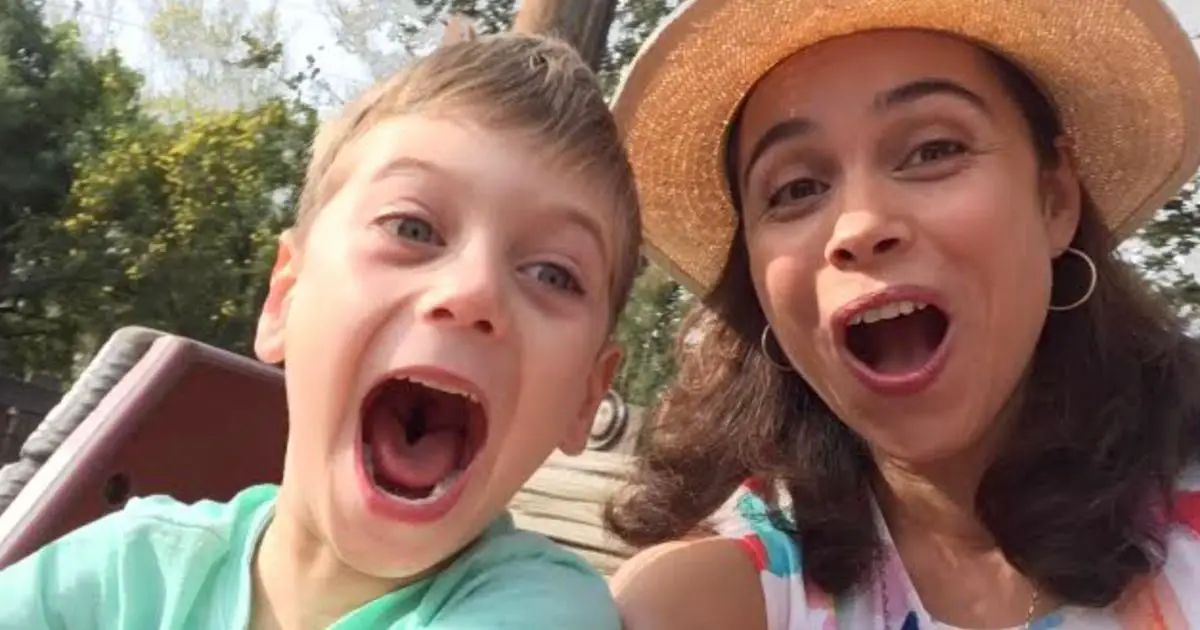
When my son was 4, I learned about the “basket hold.” What sounds like a method a mother would use to cradle a newborn baby is, in fact, a technique used to restrain a child who is so physically out of control that he’s a potential danger to himself and those around him.
Sitting behind my son, my legs wrapped around his, I’d hold his tiny wrists crisscrossed across his writhing body, pressing my head against the back of his shoulder to prevent him from landing a head butt. I’d hold him this way, “gently but firmly,” as the parenting books suggested, for anywhere from five to 15 minutes until, finally, the thrashing and screaming would stop. Then he’d happily resume his Lego building, and I’d slink away, trembling and baffled.
Other preschoolers had tantrums. My son raged. As he did, I struggled to maintain the cool veneer of calm that parenting gurus promised would soothe him. Once, I was so overwhelmed while fending off his ferocious slaps that I pushed him onto the bed and screamed, “What is wrong with you?!”
Remembering that moment — the fire running through my body, the shocked terror on his little face — absolutely kills me. So does recalling what my daughter refers to as “the time with the book”: when her big brother was 6 and became so enraged over something that no one can remember, he hurled a 250-page coffee table book across the room full force into her tiny back. I’d lunged to stop him, but I was too late. I held an ice pack to her bruise while she sobbed. Afterward, I cried and consoled myself in a locked bathroom.
Nothing I did seemed to help my son with his outbursts. No amount of breathing exercises, meditations, timeouts, rewards or punishments was enough to stave off his inevitable explosions. At night, I’d rinse frustrated tears off my face, desperately wishing my kid could be different — something other than what he was. Then, maybe I could finally feel different — anything other than what I felt — like a complete failure of a mum.
As it turns out, about 80% of children with attention-deficit/hyperactivity disorder report problems with emotional regulation. When my husband and I took our son at age 4 to an evaluation requested by his preschool, he didn’t receive an ADHD diagnosis — that would come later. But the psychologist did explain his eruptions.
“It’s as if his skin is totally permeable,” she told us. “He’s absorbing the emotions of the people around him. He’s completely overwhelmed.” My husband nodded along, as if every word the doctor spoke was self-evident, a given. But I was reeling.
The emotions of the people around him — she was talking about me. Suddenly, hundreds of bewildering battles waged with my young son clicked into striking, unmistakable logic. My attempts to coerce him into docility and my compulsion to squelch his anger, to make him calm and good at any cost, felt all too familiar — impulses that long predated motherhood.
As a child, I’d strive to twist myself into the shape of “nice.” Careful to never let my feelings spill onto the people around me, I aimed to please them with excellent grades, performances and behaviour. My adolescence was one long garbage compactor, as I shoved down one disappointment after another. I pretended to be fine when my parents divorced, pretended to be fine waiting hours for my dad, who always showed up late, and pretended to be fine when he stopped coming at all. I shrugged and pushed it all down, in hopes my silence and stoicism would earn me that most coveted of all labels — good — and that ultimate, definitive stamp — worthy.
Now, here I was, trying to force this motherfucking legacy onto my son.
“The doctor’s words that day were a turning point, helping me realize that not only was my son not ‘bad’ when he was raging, but also that the knot of feelings I’d been working so hard to suppress my whole life weren’t ‘bad’ either.”
The doctor’s words that day were a turning point, helping me realise that not only was my son not “bad” when he was raging, but also that the knot of feelings I’d been working so hard to suppress my whole life wasn’t “bad” either. I realised that my kid didn’t need me to help him become more compliant or good. If I wanted to help my kid navigate his outsized feelings, the place to start was by learning to navigate my own, a Lake Michigan-sized pool of which had been concealed and simmering since childhood.
After decades of good girl-ing and shoving away negative feelings, it took work to update my emotional operating system. I read books about emotions, sat in meditation retreats and filled journals. I completed a 12-week process that involved stopping each time I felt a negative emotion to recall my first time experiencing it, then replaying that moment while comforting my younger self with a grounding mantra: “I am here now, in this.”
Over the months and years that followed, I relearned how to recognise the contours of fear as it coursed through my body. I learned to witness shame as it shuddered through me: the clenching in my esophagus, the heaviness in my legs. Slowly, I developed trust that these vibrations wouldn’t sweep me away. And finally, when both she and I were ready, I pulled my inner child onto my lap and let her rip with rage while I held her — gently, firmly — as I’d held my son so many times in his basket hold.
Getting comfortable with my own feelings gradually helped me get more comfortable with my son’s. I could spot the fear and shame that was bubbling beneath his rage because I recognised the same pattern in myself. I swapped panicked attempts to “calm him down” for reassurances that anger and fear aren’t emergencies to be “fixed.” I practiced repeating to him the words I was learning to believe for myself: “Anger is normal. Nothing is going wrong right now.”
As it turns out, nothing was going wrong for my son. After we received his ADHD diagnosis at age 8, I learned that anger and irritability can be part and parcel of the condition. Not only do many people with ADHD have executive function challenges that inhibit emotional regulation, but they may also experience high “affective intensity.” This means they may feel emotions, especially negative ones, more deeply than a neurotypical person.
Without medication (and sometimes even with it), my son felt everything — annoyance at a loud sound, frustration at a bottle that wouldn’t open easily, indigence at not being the one to open the door first — at somewhere near a 10 out of 10. That’s an exhausting way for anyone to live, to say nothing of the drain on us caretakers who want nothing more than to help.
I joined a support group for parents of neurodivergent, highly sensitive and strong-willed kids. Hearing stories from other mums dealing with the same issues helped me get comfortable meeting my child’s rage with validation. I finally got that what kids need most in these moments is an ally — someone who can come alongside them when they’re in a tailspin and show them how to steer out of the emotional flood. That doesn’t happen by slamming the brakes (which never works), but instead by counterintuitively steering into the skid and aiming for a steady point on the horizon while gradually decreasing acceleration.
Finally, one spring day when my son was 8, it all clicked. We were standing face-to-face on the stairs to his bedroom. I was up above; he was one step below. He reached out with both hands to shove me aside, and as he did, I also reached out, our hands and eyes locking together.
Suddenly, my perspective zoomed up and out, and I was looking down on the scene from above. I saw a mom who was scared but also loved her son fiercely, doing everything she could to help him. And I saw a boy who wanted with all his heart to be good but also wrestled with anxiety masquerading as rage, letting it all out for his mom to see.
After all the work I’d done to understand anger, both my own and his, in that moment, I was able to grasp something new: the profound tenderness hidden in the heart of rage. I realized how showing up vulnerably — trusting another person to see all the messiness feelings can bring — is a gift. This wasn’t a moment for scolding or shame. It was a moment to be welcomed.
So this time, when my son reared back to land another blow, I caught his fist gently, pulled both of his hands to my heart, and said, “Thank you. Thank you for showing me how hard this is for you.”
“For the first time in my life, I wasn’t afraid of anger. I didn’t want him to be or feel anything different. I saw that I could bear witness to these waves of feelings just as I’d done for myself, all without leaping to smother or change them.”
My kid visibly softened, the torrent of his fury interrupted by this expression of gratitude. I drew him closer. For the first time in my life, I wasn’t afraid of anger. I didn’t want him to be or feel anything different. I saw that I could bear witness to these waves of feelings just as I’d done for myself, all without leaping to smother or change them.
This “thank you” response worked that day and has worked many days since then to take the edge off my kid’s rage and shift my own perspective. But I wouldn’t call it a magic bullet. While things have gotten so much better around our house, it’s likely been a confluence of things — getting a proper diagnosis, starting medication that helps my son feel less like he’s doing life with an enormous basketball in front of his face, a maturing prefrontal cortex and me finally getting “cool” with anger — that’s resulted in way less rage than those chaotic early years. But still, even with all this work, treatment and support, some days and weeks can still be just plain hard.
Being a parent has meant learning to hold more than one truth at a time. On the one hand, kids with ADHD will likely struggle with emotional regulation regardless of how we parents respond. On the other, the response we choose has the power to exacerbate or mitigate those challenges. My attempts to make my child good and calm weren’t the cause of my son’s meltdowns, but my panic and distress over the fierceness of his emotional dysregulation only made everything worse.
Ultimately, mothering my kid, in all his big-feeling splendour, has expanded my fundamental understanding of what “good mums” are. Good mums aren’t the ones with the “nicest” kids. Good mums are the ones who can open wider than they ever imagined to the rush of rage or shame that can come through a human body without making it mean anything about goodness or worthiness. Good mums are the ones who can catch flying fists with tenderness and recognition and see past the angry shouting to the disappointment or grief flooding just beneath. And good mums are the ones who can hold on — firmly, gently — as one deeply feeling heart opens vulnerably to another with support and commiseration, reassuringly telling their child, “Yes, my darling, I know. Living in a body and feeling so much is hard. We can feel it all and figure it out together.”
Marika Páez Wiesen is a writer and coach who helps mums of strong-willed kids learn to live and parent with more ease and satisfaction. She writes the newsletter Living the In-Between Times, where she helps readers ditch perfect so they can uncover the delight, awe and worth-full-ness available in life’s in-between times.
Do you have a compelling personal story you’d like to see published on HuffPost? Find out what we’re looking for here and send us a pitch at pitch@huffpost.com.








